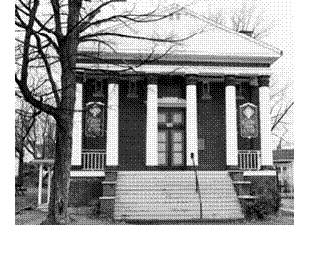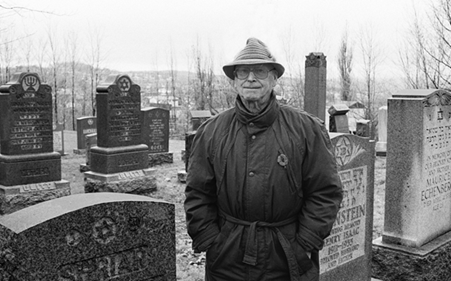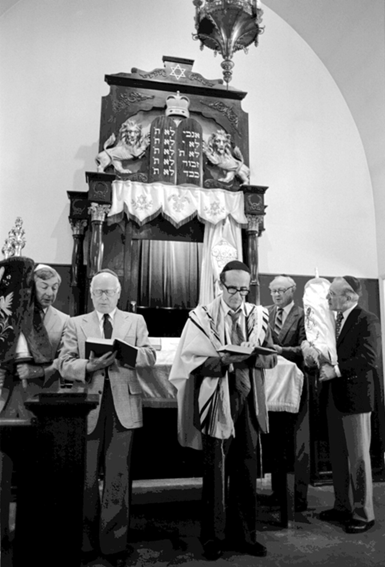histories of the jewish community of sherbrooke
THE LAST JEWS OF SHERBROOKE
by Louise Abbott
From “The last Jews from Sherbrooke” by Louise Abbott
(Montreal Forum 3(3):2-6, March 2008)

Former Agudath Achim Synagogue
The story of the once thriving Jewish community of Sherbrooke, Quebec, has been well captured in words and photographs by Louise Abbott. We warmly welcome her contribution to our pages. Born in Montreal and now living in the Eastern Townships, Louise is an award-winning writer, photographer and filmmaker. This article, which first appeared in The Montreal Gazette on 7 April 2001, won the Norman Kucharsky Award for Cultural and Artistic Journalism given by the Professional Writers Association of Canada. It was reprinted in Quebec Heritage News in December 2007.
As we stood at the gate of the Jewish cemetery, Daniel (“Danny”) Heilig cinched the belt of his overcoat and then tugged on his tweed hat to keep it from blowing away. It was a chilly, wet day in early November. Most of the leaves from the tall, moss-covered maples lay in a sodden mat on the ground. But one faded orange straggler had caught on the cemetery fence and kept slapping against the chain links, unwilling, it seems, to join the dead.
When Jews gather in Sherbrooke these days, it is to mourn. The graveyard on du Souvenir has become their main connection to an era that has passed, to a community that has disappeared. Vinebergs … Gillmans … Budnings … Cohens … Echenbergs … Greens … Smiths … Levinsons … Weinsteins. As we walked through the grounds high on a hill overlooking the city, Danny pointed out headstones and occasionally wiped away the drizzle that formed a fine mist on his glasses. Now eighty-six, he had been a friend, colleague, or relative of many of the deceased.
“My late uncle and aunt,” he gestured. Ben and Rose Cohen raised Danny after his mother’s death; he was just ten when he left Montreal to live with them. “Claire’s mother,” he gestured again. Claire is Danny’s wife, who was waiting for us in the car at the cemetery entrance. Her mother was a Polish-born Jew who had settled in New York but chosen to spend eternity close to her daughter.
We saw small headstones of lichen-spotted white marble that dated from nearly a century ago and larger headstones of polished black granite from more recent years. We also saw one grave that had been freshly dug. Danny explained that a monument would eventually be placed, and then family and friends would gather for an official unveiling and mourners’ kaddish, or prayer.
Like Danny and Claire, the woman who had died had once been part of a small, but thriving, Jewish community. Only a handful of Jews remain. As one of them, Danny had offered to escort me to the cemetery and then drive me around the city to show me where Jewish inhabitants used to live, work, and worship.
While he locked the gate, I looked up at the wrought-iron arch above it. It bore a Star of David and the words “Congregation of Agudath Achim Cemetery.”
This burial ground in Sherbrooke’s east end has been vandalized in recent years. But back in the car, the Heiligs emphasized that the desecration was a regrettable, but isolated, incident: the local Jewish community had traditionally experienced tolerance and goodwill. “We always had a very comfortable relationship with the English people,” Claire said, “Well, also with the French, we had a very good entente,” Danny quickly added. “But not as close,” Claire concluded.
Even before pograms caused them to flee the shtetls of Russia and other Eastern European nations en masse in the late 1800s, Jews had settled in various locales in the Eastern Townships. The greatest number took up residence in the commercial centre of Sherbrooke.
An advocate named Reuben Hart arrived first; he was listed in the 1863 census. By 1881 twenty Jews were registered. They continued to arrive throughout the 1880s and 1890s. Danny’s uncle Ben founded the B. Cohen Corporation in
1887; he dealt in scrap metal, rags, and animal bones, hides, and furs. “Farmers and trappers would bring in raw furs, which were sold to coat manufacturers,” Danny said.
In a pattern that repeated itself all over North America, Jewish newcomers often worked initially as peddlers. “They would take a pack and some merchandise and go out into the countryside with a horse and cart,” Claire explained. “They would sell their goods, make a slight profit, and buy more merchandise. They had nothing but innate intelligence, a great deal of ambition, the desire to survive, and a sense of charity—an ability to give part of what they had to relatives to help them.”
As they prospered, most of these itinerant salesmen opened clothing stores, furniture stores, or other retail businesses on Wellington in downtown Sherbrooke. For several decades, Jews owned almost half of the stores on this street.
By 1907 the Jewish community had grown large enough to engage a rabbi, obtain a charter for their congregation and rent quarters for services and other activities. After we had wended our way from the cemetery and crossed the St. Francis River, Danny slowed down at Dufferin and Frontenac. “That corner had the building that housed our first little place of worship.”

Originally an anglophone stronghold, Sherbrooke had witnessed a demographic shift by the turn of the twentieth century; French Canadians had come to constitute the majority of the residents. Nonetheless, English-speaking locals remained economically and politically powerful, and it was with them that Jewish citizens aligned themselves. Jews usually started off in leased living quarters close to their shops. When they could afford it, they moved into themostly middle-class, mostly English-speaking, North Ward.
Jewish children went to Protestant schools, and Yiddish gave way to English at home. Many Jewish parents did business with French Canadians, however, and urged their children to learn French.
With fewer than fifteen thousand people in the early 1900s, Sherbrooke was a “New World shtetl … a place to conduct small business and maintain solid family ties,” Ruth (Echenberg) Tannenbaum and Myron Echenberg noted in a family history.
Today, with upwards of seventy-six thousand residents in its core, Sherbrooke still offers a relaxed tempo. “I get high blood pressure from the traffic and pace of a big city,” Danny said, as he navigated slowly, cautiously, from downtown to the North Ward.
We stopped in front of a neo-classical brick building with white pillars on Montreal Street. Now a French Pentecostal church, it was erected in 1920 as the Agudath Achim Synagogue and served families not only from Sherbrooke, but also from outlying towns like Coaticook, Drummondville, Lake Megantic, and Thetford Mines.
While thecongregation was nominally Orthodox, secular Jewish institutions dominated synagogue life: B’nai B’rith, Hadassah, Hebrew Ladies’ Aid. A cheder, or elementary Hebrew school, was held after regular school classes and on Sunday mornings.
By 1921 the number of Jews in Sherbrooke had reached 265 in an overall population of 23,660. A wave of Jewish immigrants arrived that year and the next. For some, Sherbrooke was a final destination, for others, a stopover. By
1931 the number of Jews had slipped to
152. The Great Depression was one factor in the exodus. The search for Jewish spouses was another.
In 1937 clothing manufacturer Sam Rubin moved his operation from Montreal to Sherbrooke to resist unionization. About twenty- five Jewish families accompanied him, bringing “stronger ties to Judaism and to Yiddish culture,” according to Tannenbaum and Echenberg, and, in the younger generation, potential Jewish marriage partners.
Although forming a tightly knit community, Jews looked beyond their own ranks, too. Many served on the board of the Sherbrooke Hospital, the YMCA, the Rotary Club, and other Anglophone organizations. In both wars, many enlisted for military service.
During the post-war boom, the Jewish community remained vibrant, and it was then that Danny and Claire began their life together. In 1947 Danny took over his uncle Ben’s business with his cousin Sam. The same year, he met Claire in Montreal. She was visiting a friend: he was bowling in a B’nai B’rith- sponsored tournament.
Claire, whose accent bears the unmistakable stamp of her New York Jewish childhood, has never forgotten the day that Danny proposed. “I asked: Does Sherbrooke have any movie houses? Does it have indoor plumbing?” She laughed. “I thought Sherbrooke was backward,” she admitted. “I never asked about the Jewish community. Jewish culture was something I’d always taken for granted.”

Claire married Danny in 1948 and upon her arrival in Sherbrooke, she immediately found a friend in another transplanted American Jewish woman. She also gradually found her place inthe local Jewish community. For years, she “didn’t wander out of it at all, didn’t want to, didn’t need to.”
Continuing along streets in the North Ward, where the Heiligs themselves live, we saw the onetime homes of various Jewish families. The neighbourhood today is predominantly francophone. Danny speaks French and plays tennis once a week with longstanding francophone friends. Claire, however, never became fully bilingual. As the Jewish community shrank, she became increasingly involved in the broader anglophone community, only curtailing her involvement in associations like the University Women’s Club after two strokes in 1997.
On our return to the Heiligs’ apartment, Danny retrieved a box with photos from the 1950s and
1960s inside. He picked out a few including the bar mitzvah of his son, Lewis; a Hanukkah party; and a B’nai B’rith fund-raising dinner. He rhymed off the names of the smiling faces and then added wistfully, “It was a very friendly
group.”
In 1955, with three hundred-odd members, the Jewish community was confident enough of its future to construct a two-story extension to the synagogue to accommodate a Talmud Torah, or religious school for bar mitzvah preparation; meeting rooms; and other facilities. Just a year later, Sam Rubin sold his King Street plant to an American company. A year after that, as the needle trades in Quebec faltered, the plant closed. Most of the Jewish employees departed. In addition, the children of even deeply rooted Jews continued to go elsewhere for their education, marriage, and careers. Many became well-known professionals in Montreal, such as criminal lawyer Raphael Schachter, the grandson of the Rev. A. S. Mittleman, Agudath Achim’s spiritual leader from 1919 to 1954.
During the 1960s, shopping malls sprang up in the suburbs, and Wellington Street stores found it hard to compete. Some of the Jewish owners pulled up stakes. By 1967 the Sherbrooke Daily Record reported: “Sherbrooke’s Jewish community struggles to continue.”
The back-to-the-land movement and staff hiring at local CEGEPs, universities, and hospitals brought a few new congregants. Among them were artists Chick and Marsha Schwartz. They had left Montreal in 1977 to settle on a farm outside Stanstead and wanted their three sons to study for their bar mitzvah. They soon discovered that the Sherbrooke congregation no longer had a resident rabbi, and the Talmud Torah had all but collapsed. Marsha set about resurrecting classes with the assistance of the Heiligs’ daughter, Robin, then a Bishop’s University student.
It became more and more difficult, however, to draw a minyan, or quorum of ten adult males required to hold religious services, and the remaining synagogue members faced crippling maintenance and repair expenses for the building. They made the painful decision to sell it, directing the funds to a foundation established for the cemetery’s upkeep. About seventy people from near and far attended the last service in
1983. “It was a reunion and a farewell,” Claire recalled.
Some former congregants took to commuting to synagogues in Vermont or Montreal to worship and educate their children in Judaism. Others created the Eastern Townships Jewish Community. At its peak in the late 1980s, this informal group brought together fifty widely dispersed Jewish or interfaith Townships families. Members met in different homes for children’s instruction, special services, and communal celebrations.
The Heiligs were delighted to see this resurgence of Jewish life in the region and joined in. But in the intervening years, most of the children have grown up and left to study or work outside the Townships. Some of the parents have moved, too. Get-togethers are rare.
Danny put away the photos. “I was sad when my friends left,” Claire said. “But I’ve learned to accept it.” The Heiligs decided long ago that they would stay in Sherbrooke forever; they have reserved plots in the Agudath Achim Cemetery for themselves and their two children. “We love it here, and our roots are here,” Danny told me. “When people used to ask me about moving, I’d always say, I’m going to turn out the lights in the synagogue, and we’ll be the last to leave.”
From “The last Jews from Sherbrooke” by Louise Abbott (Montreal Forum 3(3):2-6, March 2008)
